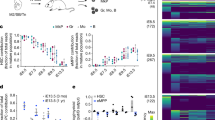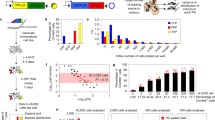Abstract
Haematopoietic stem cells (HSCs) arise in the developing aorta during embryogenesis. The number of HSC clones born has been estimated through transplantation, but experimental approaches to assess the absolute number of forming HSCs in a native setting have remained challenging. Here, we applied single-cell and clonal analysis of HSCs in zebrafish to quantify developing HSCs. Targeting creERT2 in developing cd41:eGFP+ HSCs enabled long-term assessment of their blood contribution. We also applied the Brainbow-based multicolour Zebrabow system with drl:creERT2 that is active in early haematopoiesis to induce heritable colour barcoding unique to each HSC and its progeny. Our findings reveal that approximately 21 HSC clones exist prior to HSC emergence and 30 clones are present during peak production from aortic endothelium. Our methods further reveal that stress haematopoiesis, including sublethal irradiation and transplantation, reduces clonal diversity. Our findings provide quantitative insights into the early clonal events that regulate haematopoietic development.








Similar content being viewed by others
Change history
20 December 2016
In the version of this Article originally published, the colours of the flow cytometry gates in Fig. 1b were incorrect. The gates labelled 'Erythroid', 'Myeloid', 'Lymphoid' and 'Precursor' should have been coloured purple, red, green and blue, respectively. In addition, the first author of ref. 26 was incorrect and this has now been changed to 'Mosimann, C'. These errors have been corrected in the online versions of the Article.
References
Bertrand, J. Y. et al. Haematopoietic stem cells derive directly from aortic endothelium during development. Nature 464, 108–111 (2010).
Chen, M. J., Yokomizo, T., Zeigler, B. M., Dzierzak, E. & Speck, N. A. Runx1 is required for the endothelial to haematopoietic cell transition but not thereafter. Nature 457, 887–891 (2009).
Zovein, A. C. et al. Fate tracing reveals the endothelial origin of hematopoietic stem cells. Cell Stem Cell 3, 625–636 (2008).
Boisset, J.-C. et al. In vivo imaging of haematopoietic cells emerging from the mouse aortic endothelium. Nature 464, 116–120 (2010).
Kissa, K. et al. Live imaging of emerging hematopoietic stem cells and early thymus colonization. Blood 111, 1147–1156 (2008).
Tamplin, O. J. et al. Hematopoietic stem cell arrival triggers dynamic remodeling of the perivascular niche. Cell 160, 241–252 (2015).
Kumaravelu, P. et al. Quantitative developmental anatomy of definitive haematopoietic stem cells/long-term repopulating units (HSC/RUs): role of the aortagonad–mesonephros (AGM) region and the yolk sac in colonisation of the mouse embryonic liver. Development 129, 4891–4899 (2002).
Sun, J. et al. Clonal dynamics of native haematopoiesis. Nature 514, 322–327 (2014).
Kim, S. et al. Dynamics of HSPC repopulation in nonhuman primates revealed by a decade-long clonal-tracking study. Cell Stem Cell 14, 473–485 (2014).
Jordan, C. T. & Lemischka, I. R. Clonal and systemic analysis of long-term hematopoiesis in the mouse. Genes Dev. 4, 220–232 (1990).
Hess, I., Iwanami, N., Schorpp, M. & Boehm, T. Zebrafish model for allogeneic hematopoietic cell transplantation not requiring preconditioning. Proc. Natl Acad. Sci. USA 110, 4327–4332 (2013).
Ma, D., Zhang, J., Lin, H., Italiano, J. & Handin, R. I. The identification and characterization of zebrafish hematopoietic stem cells. Blood 118, 289–297 (2011).
Bertrand, J. Y., Kim, A. D., Teng, S. & Traver, D. CD41+ cmyb+ precursors colonize the zebrafish pronephros by a novel migration route to initiate adult hematopoiesis. Development 135, 1853–1862 (2008).
Hans, S. et al. Generation of a non-leaky heat shock-inducible Cre line for conditional Cre/lox strategies in zebrafish. Dev. Dynam. 240, 108–115 (2011).
Xu, J. et al. Temporal-spatial resolution fate mapping reveals distinct origins for embryonic and adult microglia in zebrafish. Dev. Cell 34, 632–641 (2015).
Kissa, K. & Herbomel, P. Blood stem cells emerge from aortic endothelium by a novel type of cell transition. Nature 464, 112–115 (2010).
Dixon, G., Elks, P. M., Loynes, C. A., Whyte, M. K. B. & Renshaw, S. A. A method for the in vivo measurement of zebrafish tissue neutrophil lifespan. ISRN Hematol. 2012, 1–6 (2012).
Livet, J. et al. Transgenic strategies for combinatorial expression of fluorescent proteins in the nervous system. Nature 450, 56–62 (2007).
Pan, Y. A. et al. Zebrabow: multispectral cell labeling for cell tracing and lineage analysis in zebrafish. Development 140, 2835–2846 (2013).
Weissman, T. A. & Pan, Y. A. Brainbow: new resources and emerging biological applications for multicolor genetic labeling and analysis. Genetics 199, 293–306 (2015).
Gupta, V. & Poss, K. D. Clonally dominant cardiomyocytes direct heart morphogenesis. Nature 484, 479–484 (2012).
Loulier, K. et al. Multiplex cell and lineage tracking with combinatorial labels. Neuron 81, 505–520 (2014).
Snippert, H. J. et al. Intestinal crypt homeostasis results from neutral competition between symmetrically dividing Lgr5 stem cells. Cell 143, 134–144 (2010).
Martinez, R. J., Neeld, D. K. & Evavold, B. D. Identification of T cell clones without the need for sequencing. J. Immunol. Methods 424, 28–31 (2015).
Mosimann, C. et al. Ubiquitous transgene expression and Cre-based recombination driven by the ubiquitin promoter in zebrafish. Development 138, 169–177 (2011).
Mosimann, C. et al. Chamber identity programs drive early functional partitioning of the heart. Nat. Commun. 6, 8146 (2015).
Busch, K. et al. Fundamental properties of unperturbed haematopoiesis from stem cells in vivo. Nature 518, 542–546 (2015).
Catlin, S., Busque, L. & Gale, R. The replication rate of human hematopoietic stem cells in vivo. Blood 117, 4460–4466 (2011).
Arora, N. et al. Effect of developmental stage of HSC and recipient on transplant outcomes. Dev. Cell 29, 621–628 (2014).
Lu, R., Neff, N., Quake, S. & Weissman, I. Tracking single hematopoietic stem cells in vivo using high-throughput sequencing in conjunction with viral genetic barcoding. Nat. Biotechnol. 29, 928–933 (2011).
Shlush, L. I. et al. Identification of pre-leukaemic haematopoietic stem cells in acute leukaemia. Nature 506, 328–333 (2014).
Steensma, D. P. et al. Clonal hematopoiesis of indeterminate potential and its distinction from myelodysplastic syndromes. Blood 126, 9–16 (2015).
Ablain, J., Durand, E. M., Yang, S., Zhou, Y. & Zon, L. I. A CRISPR/Cas9 vector system for tissue-specific gene disruption in zebrafish. Dev. Cell 32, 756–764 (2015).
Westerfield, M. The Zebrafish Book. A Guide for the Laboratory Use of Zebrafish (Danio rerio) 5th edn (Univ. Oregon Press, 2007).
Lin, H.-F. et al. Analysis of thrombocyte development in CD41-GFP transgenic zebrafish. Blood 106, 3803–3810 (2005).
Traver, D. et al. Transplantation and in vivo imaging of multilineage engraftment in zebrafish bloodless mutants. Nat. Immunol. 4, 1238–1246 (2003).
Rodriguez, A. & Laio, A. Clustering by fast search and find of density peaks. Science 344, 1492–1496 (2014).
Kaufman, L. & Rousseeuw, P. J. Finding Groups in Ordinal Data. An Introduction to Cluster Analysis (Wiley-Interscience, 2005).
Acknowledgements
We thank the following for their support and contributions: M. Distel, E. Butko, J. Bertrand and D. Stachura for critical reading of the manuscript; K. Richter for laboratory management; J. Abkowitz for comments and suggestions; A. Schier and A. Pan for the Zebrabow-M line and guidance; L. Ding and D. Tom at the HMS Enhanced Neuroimaging Core for help with confocal microscopy. This work was supported by HHMI and NIH F31HL126338 (J.H.), NIH R01-DK074482 (D.T.), NIH F32DK752433 (B.S.), the Deutsche Forschungsgemeinschaft (SFB655), the TU Dresden and the European Union (Zf Health), NIH R01-HL04880, NIH P01-HL032262, NIH 5P30-DK49216, NIH 5R01-DK53298, NIH 5U01-HL10001, NIH R24-DK09276 and an MPN Research Foundation Grant. C.M. received funding from an EMBO long-term fellowship, an HSFP long-term fellowship, an SNF advanced fellowship and an SNF professorship.
Author information
Authors and Affiliations
Contributions
J.H. and B.S. designed and carried out experiments, analysed the data, and wrote the manuscript. B.S. and S.H. designed and carried out laser fate mapping experiments. E.D. and J.M. carried out experiments. C.M., M.B., D.T. and L.Z. designed experiments, edited the manuscript and supervised the project.
Corresponding authors
Ethics declarations
Competing interests
L.Z. is a founder and stock holder of Fate, Inc., and Scholar Rock.
Integrated supplementary information
Supplementary Figure 1 Heat-shock and 4-OHT requirement for DsRed-Express labeling.
(a) Strategy to validate dual-inducible fate mapping system. (b) DsRed-Express and mCherry expression in double transgenic embryos Tg(bactin2:switch; hsp70l:mCherry-T2A-CreERT2) in the presence or absence of heat shock at 24 h post-fertilization (hpf), and in the presence or absence of 4-hydroxytamoxifen (4-OHT). Top, representative brightfield image of an embryo. Box, region of embryo in fluorescence images. Left column, DsRed-Express signals. Right column, mCherry signals. Dash, outline of embryo. Embryos were imaged at 5 days post-fertilization (dpf). Scale bar is 200 μm.
Supplementary Figure 2 Migration of labeled cd41:eGFP+ cells from VDA to thymus.
(a) Scheme of laser induction targeting 10 cd41:eGFP+ cells in VDA of triple transgenic Tg(cd41:eGFP; bactin2:switch; hsp70l:mCherry-T2A-CreERT2). (b) cd41:eGFP+ target cells in VDA. Top, transgene. Middle, transgenic embryo at 50 hpf (scale bar = 200 μm).; box, enlarged region (Scale bar is 50 μm). Bottom, close up of VDA. Arrows, cd41:eGFP+ cells in the VDA. Arrowheads, non-haematopoietic cd41:eGFP+ cells in pronephric duct. (c) Quantification of cd41:eGFP+DsRed-Express+ cells in one thymic lobe, with or without laser induction. All z-planes were analyzed. Error bars, s.e.m. ∗P = 0.036, two-tailed t-test (n = 8 for no heat shock, n = 8 for laser induction). (d) Representative confocal images (one z-plane shown) of thymi of 3-dpf embryos. Top row, whole embryo heat shock. Middle row, no heat shock. Bottom row, laser induction. Dash, outline of thymus. Left column, cd41:eGFP. Middle column, DsRed-Express. Right column, merged images (scale bar = 50 μm).
Supplementary Figure 3 Characterization of draculin reporter activity in HSPCs.
(a) Strategy to measure co-expression of drl:eGFP and Runx1 + 23:nls-mCherry, a stem cell reporter. (b) Time-lapse imaging of the VDA, showing a single drl:eGFP+;Runx1 + 23:nls-mCherry+ cell budding from the ventral wall of the dorsal aorta at 40 hpf and entering circulation four hours later (A = dorsal aorta, V = cardinal vein, arrows denote blood flow, scale bar = 10 μm). (c) Confocal image showing the co-expression of drl:eGFP + and Runx1 + 23:nls-mCherry in five stem cells that have engrafted in the CHT at 48 hpf (DA = dorsal aorta, arrows = blood flow, scale bar = 25 μm). (d) Representative flow cytometry plots showing expression and co-expression of drl:eGFP and Runx1 + 23:nls-mCherry in pooled whole embryos at 36 hpf. (e) Quantification of Runx1 + 23:nls-mCherry cells that are positive for drl:eGFP expression by flow cytometry at various developmental stages in pooled embryos. (f) Representative flow cytometry plot of FSC/SSC characteristics and back-gating of drl:eGFP+ and drl:eGFP+Runx1+23:mCherry+ cells from whole kidney marrow. (g) Transplant of 6 × 104 drl:eGFP+ubi:mCherry+ cells from the lymphoid/progenitor and precursor gates into lethally irradiated recipients. Recipient marrow was analyzed at 3 months post-fertilization. Here we show a representative FACS plot, demonstrating recapitulation of drl:eGFP expression and multilineage reconstitution demonstrated by the presence of ubi:mCherry in all populations. (h) Quantification of chimerism levels in recipient zebrafish. Each marker corresponds to an individual animal. (green cells = drl:eGFP+, purple cells = drl:eGFP+Runx1 + 23:mCherry+, red cells = ubi:mCherry+, and grey = total live cells, n = 15 engrafted recipients)
Supplementary Figure 4 Flow cytometry of the Zebrabow fluorophores and lineage analysis of labeled marrow.
(a) Gating strategy to analyze Zebrabow fluorophores in multiple lineages. Each lineage (myeloid, lymphoid, erythroid) expresses the Zebrabow transgenes at different levels, but the relative expression of each fluorophore between populations remains the same (gates drawn based on negative, non-fluorescent controls). (b) Erythrocytes contaminate the myeloid population after filtering live, single cells. The myeloid and erythroid populations can be easily distinguished by intensity level of the fluorophores. (c) Plotting the three Zebrabow colors in three dimensions demonstrates the similar color barcodes present in all three lineages. Because the erythrocytes are relatively dim, there is much more variation in the signal. (d) The myeloid and lymphoid populations were isolated from the marrow of adults that were treated at various developmental time points by the gating strategy in (a). Three-dimensional plots of the three Zebrabow fluorophores shows that the color distribution in the myeloid and lymphoid lineages are almost identical. These are representative examples of the adults used to quantify lineage output in Fig. 3e.
Supplementary Figure 5 Evaluation of clustering quality for small clones.
(a) Tg(drl:creERT2;ubi:Zebrabow-M) embryos were treated at 96 hpf, and their marrow was analyzed by flow cytometry at 5 months to measure small clonal contributions. (b) Silhouette plots from three representative marrows evaluate the quality of the clustering solutions. Small clones that contribute <1% of the granulocyte population were detected with high silhouette values, demonstrating the low threshold for detection in this system.
Supplementary Figure 6 Analysis of single color Zebrabow animals.
(a) Breeding and treatment strategy to carry the Zebrabow recombination through the germline. (b) Example image of single color Zebrabow fish from a single clutch. Individual channels (dTomato, CFP, YFP) were imaged and merged to generate the RGB colors (scale bar = 20 mm). (c) Example ternary plots of granulocytes from marrows of adult single color zebrafish. (d) Digital combination of 100,000 labeled granulocytes from 12 individual marrows from adult fish treated at 24 hpf with 4-OHT. The 3D scatter plot shows the normalized intensities of these combined cells. The right graph shows the alpha shape volume of these cells in color space (grey), with an example single color marrow (blue) mapped into the color space. (e) These ternary graphs show the same example from (d) in 2D space. (f) Boxplot that shows quantification of the predicted number of Zebrabow colors from mapping individual single colored marrows into 2D color space (red line is median and box represents inner quartile range, n = 13 fish).
Supplementary Figure 7 Example ternary plots from fate mapping at defined developmental time points.
This figure provides example ternary diagrams that depict color barcodes in the granulocyte lineage from adult fish treated during embryogenesis. Each ternary diagram depicts an individual marrow at 24 hpf (a), 48 hpf (b), or 72 hpf (c) with labeling efficiency (% recombination) below each plot. Bar graphs on the right show the quantification of clonal contribution for each ternary diagram. Brackets (∗) correspond to large clusters that are likely to be polyclonal populations, which were ignored for predicting clonal numbers.
Supplementary Figure 8 Repeat of Zebrabow fate mapping at defined developmental time points with brief 4-OHT treatment.
(a) Strategy to fate map HSCs at defined developmental time points. In this experiment, embryos were exposed to 4-OHT for only 4 h until they were switched to fresh water. (b) Color barcodes in granulocytes were quantified and extrapolated to predict the number of clones present during label induction that contribute to adult blood (dashed line marks the beginning of definitive haematopoiesis). Each marker represents one animal. Error bars show mean and s.e.m. (n = 8, 5, 5, and 9 fish for 24, 30, 51, and 74 hpf, respectively). (c) Table showing quantification of these predicted values with 95% confidence intervals. Cluster data is available in the Supplementary Table 1.
Supplementary information
Supplementary Information
Supplementary Information (PDF 4534 kb)
Supplementary Table 1
Supplementary Information (XLSX 35 kb)
Time lapse imaging of drl:eGFP embryos.
This movie demonstrates the activity of the drl regulatory elements during definitive blood development. drl:eGFP embryos were imaged by confocal microscopy beginning at 40 hpf. GFP + cells can be seen in the vasculature and haematopoietic cells in both the ventral dorsal aorta and the caudal haematopoietic tissue (CHT). (MP4 3073 kb)
Time lapse imaging of Tg(Zebrabow-M; drl:creERT2) embryos.
Zebrabow embryos were treated with 4-OHT at 24 hpf and imaged by confocal microscopy beginning at 48 hpf. This movie shows Zebrabow labeling in the CHT in both the vasculature and haematopoietic cells. A putative stem cell resides in the center of the frame, and it eventually divides to yield progeny with identical color. (MP4 7610 kb)
Rights and permissions
About this article
Cite this article
Henninger, J., Santoso, B., Hans, S. et al. Clonal fate mapping quantifies the number of haematopoietic stem cells that arise during development. Nat Cell Biol 19, 17–27 (2017). https://doi.org/10.1038/ncb3444
Received:
Accepted:
Published:
Issue Date:
DOI: https://doi.org/10.1038/ncb3444
- Springer Nature Limited
This article is cited by
-
Dynamics of a diffusive model for cancer stem cells with time delay in microRNA-differentiated cancer cell interactions and radiotherapy effects
Scientific Reports (2024)
-
Activation of lineage competence in hemogenic endothelium precedes the formation of hematopoietic stem cell heterogeneity
Cell Research (2023)
-
Haematopoietic stem and progenitor cell heterogeneity is inherited from the embryonic endothelium
Nature Cell Biology (2023)
-
Hematopoietic heterogeneity starts at the hemogenic endothelium
Cell Research (2023)
-
Lifelong multilineage contribution by embryonic-born blood progenitors
Nature (2022)





